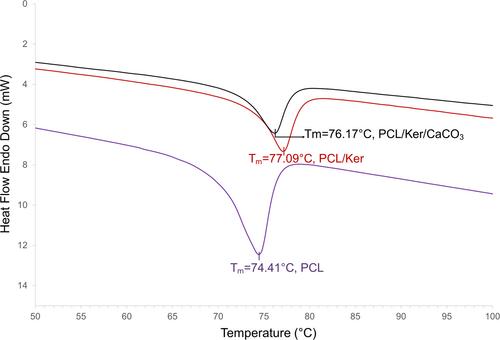下载PDF
{"title":"用于组织工程的可持续生物材料:富含淡水蜗牛碳酸钙和废人类头发角蛋白的电纺聚己内酯纤维","authors":"Özge Erdemli, Bengi Yilmaz, İrem Göksu Saran, Erdal Serin","doi":"10.1002/pi.6667","DOIUrl":null,"url":null,"abstract":"<p>This study focuses on developing a sustainable and biocompatible polycaprolactone (PCL)-based scaffold for bone tissue engineering through electrospinning, utilizing calcium carbonate (CaCO<sub>3</sub>) from <i>Pomacea canaliculata</i> shells and keratin from human hair, known for stimulating bone regeneration. The isolated CaCO<sub>3</sub> has been identified to demonstrate two polymorphs, vaterite and calcite, as determined by X-ray diffraction. The isolation of keratin from human hair was confirmed through sodium dodecyl sulfate polyacrylamide gel electrophoresis and Fourier transform infrared spectroscopy analysis, revealing the presence of <i>α</i>-keratin structures around 45–50 kDa and <i>β</i>-keratin structures around 55–60 kDa. According to scanning electron microscope observations, the addition of keratin to PCL fibers reduced their diameter from 457 ± 345 to 371 ± 103 nm. Further addition of calcium carbonate led to a mean diameter of 258 ± 76 nm. The melting temperature of PCL fibers containing keratin and CaCO<sub>3</sub> was determined to be 76.17 °C via differential scanning calorimetry, while thermogravimetric analysis, conducted at temperatures up to 600 °C, revealed a remaining ash content of 9.59%. Calcium phosphate accumulation was observed to initiate on PCL fibers containing keratin and CaCO<sub>3</sub> following a 7-day exposure to simulated body fluid. The fibers exhibit cytocompatibility, showing no toxicity while supporting the growth and proliferation of Saos-2 osteosarcoma cells. The results suggest that the innovative incorporation of keratin and CaCO<sub>3</sub> into PCL nanofibers could serve as a bioactive matrix compared to pure PCL matrices, thereby offering enhanced potential for bone tissue engineering applications. © 2024 The Author(s). <i>Polymer International</i> published by John Wiley & Sons Ltd on behalf of Society of Chemical Industry.</p>","PeriodicalId":20404,"journal":{"name":"Polymer International","volume":"73 10","pages":"833-843"},"PeriodicalIF":2.9000,"publicationDate":"2024-06-03","publicationTypes":"Journal Article","fieldsOfStudy":null,"isOpenAccess":false,"openAccessPdf":"https://onlinelibrary.wiley.com/doi/epdf/10.1002/pi.6667","citationCount":"0","resultStr":"{\"title\":\"Sustainable biomaterials for tissue engineering: electrospun polycaprolactone fibers enriched with freshwater snail calcium carbonate and waste human hair keratin\",\"authors\":\"Özge Erdemli, Bengi Yilmaz, İrem Göksu Saran, Erdal Serin\",\"doi\":\"10.1002/pi.6667\",\"DOIUrl\":null,\"url\":null,\"abstract\":\"<p>This study focuses on developing a sustainable and biocompatible polycaprolactone (PCL)-based scaffold for bone tissue engineering through electrospinning, utilizing calcium carbonate (CaCO<sub>3</sub>) from <i>Pomacea canaliculata</i> shells and keratin from human hair, known for stimulating bone regeneration. The isolated CaCO<sub>3</sub> has been identified to demonstrate two polymorphs, vaterite and calcite, as determined by X-ray diffraction. The isolation of keratin from human hair was confirmed through sodium dodecyl sulfate polyacrylamide gel electrophoresis and Fourier transform infrared spectroscopy analysis, revealing the presence of <i>α</i>-keratin structures around 45–50 kDa and <i>β</i>-keratin structures around 55–60 kDa. According to scanning electron microscope observations, the addition of keratin to PCL fibers reduced their diameter from 457 ± 345 to 371 ± 103 nm. Further addition of calcium carbonate led to a mean diameter of 258 ± 76 nm. The melting temperature of PCL fibers containing keratin and CaCO<sub>3</sub> was determined to be 76.17 °C via differential scanning calorimetry, while thermogravimetric analysis, conducted at temperatures up to 600 °C, revealed a remaining ash content of 9.59%. Calcium phosphate accumulation was observed to initiate on PCL fibers containing keratin and CaCO<sub>3</sub> following a 7-day exposure to simulated body fluid. The fibers exhibit cytocompatibility, showing no toxicity while supporting the growth and proliferation of Saos-2 osteosarcoma cells. The results suggest that the innovative incorporation of keratin and CaCO<sub>3</sub> into PCL nanofibers could serve as a bioactive matrix compared to pure PCL matrices, thereby offering enhanced potential for bone tissue engineering applications. © 2024 The Author(s). <i>Polymer International</i> published by John Wiley & Sons Ltd on behalf of Society of Chemical Industry.</p>\",\"PeriodicalId\":20404,\"journal\":{\"name\":\"Polymer International\",\"volume\":\"73 10\",\"pages\":\"833-843\"},\"PeriodicalIF\":2.9000,\"publicationDate\":\"2024-06-03\",\"publicationTypes\":\"Journal Article\",\"fieldsOfStudy\":null,\"isOpenAccess\":false,\"openAccessPdf\":\"https://onlinelibrary.wiley.com/doi/epdf/10.1002/pi.6667\",\"citationCount\":\"0\",\"resultStr\":null,\"platform\":\"Semanticscholar\",\"paperid\":null,\"PeriodicalName\":\"Polymer International\",\"FirstCategoryId\":\"92\",\"ListUrlMain\":\"https://onlinelibrary.wiley.com/doi/10.1002/pi.6667\",\"RegionNum\":4,\"RegionCategory\":\"化学\",\"ArticlePicture\":[],\"TitleCN\":null,\"AbstractTextCN\":null,\"PMCID\":null,\"EPubDate\":\"\",\"PubModel\":\"\",\"JCR\":\"Q2\",\"JCRName\":\"POLYMER SCIENCE\",\"Score\":null,\"Total\":0}","platform":"Semanticscholar","paperid":null,"PeriodicalName":"Polymer International","FirstCategoryId":"92","ListUrlMain":"https://onlinelibrary.wiley.com/doi/10.1002/pi.6667","RegionNum":4,"RegionCategory":"化学","ArticlePicture":[],"TitleCN":null,"AbstractTextCN":null,"PMCID":null,"EPubDate":"","PubModel":"","JCR":"Q2","JCRName":"POLYMER SCIENCE","Score":null,"Total":0}
引用次数: 0
引用
批量引用



